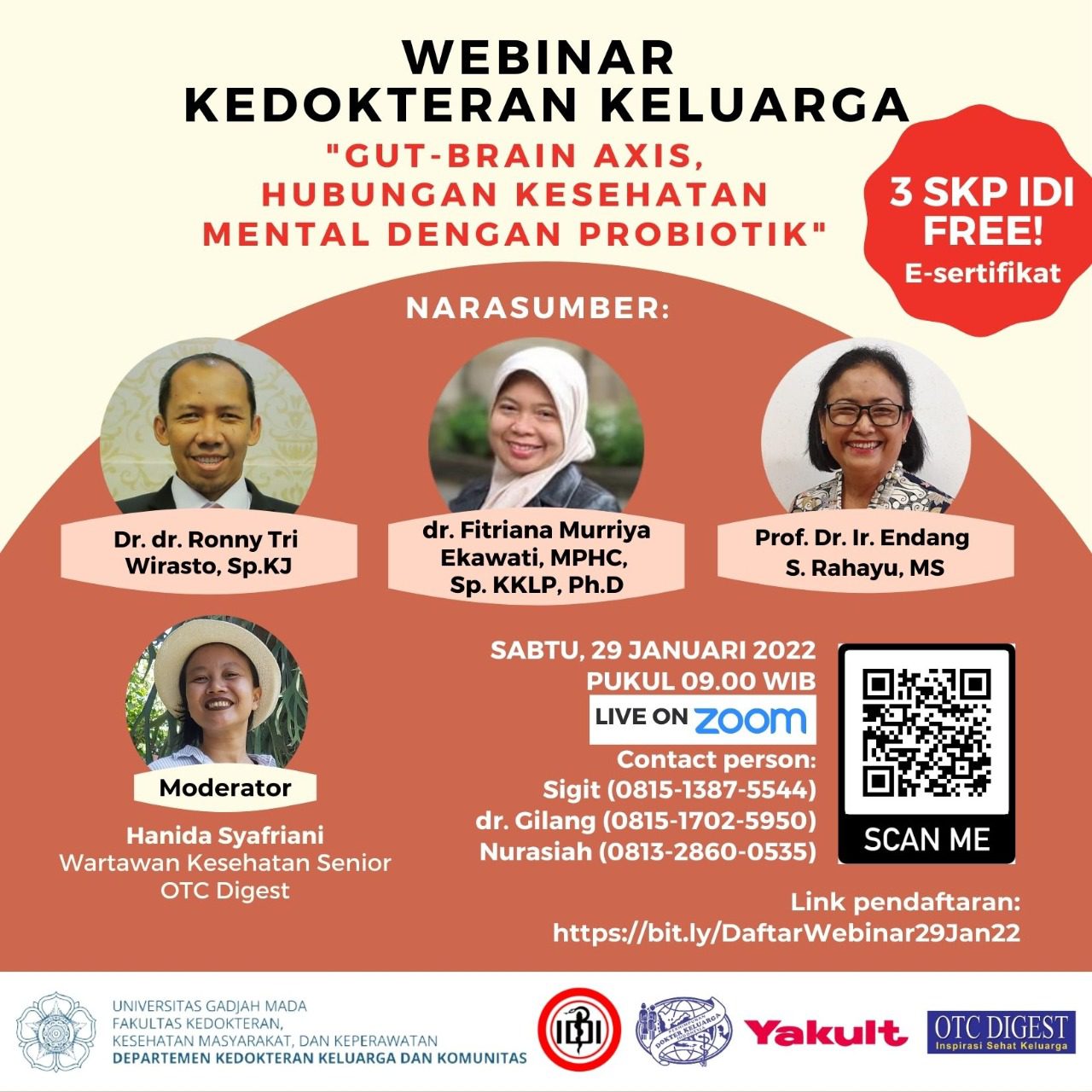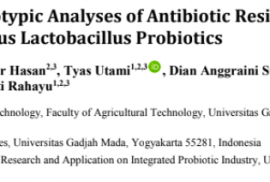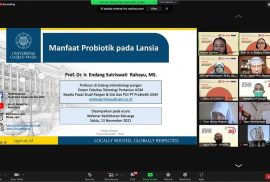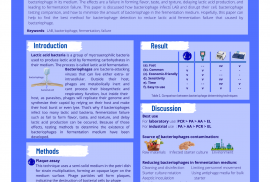Pada hari Sabtu, 29 Januari 2022 Pusat Studi Pangan dan Gizi UGM dan PUI-PT Probiotik berpartisipasi dalam Webinar Kedokteran Keluarga dengan topik “Gut-Brain Axis, Hubungan Kesehatan Mental dengan Probiotik”. Pada webinar ini, Prof. Dr. Ir. Endang Sutriswati Rahayu, M.S., selaku Kepala PSPG dan PUI-PT Probiotik berkesempatan menjadi narasumber bersama Dr. dr. Ronny Tri Wirasto, Sp.KJ (Dokter spesialis kesehatan jiwa di RSUP Dr. Sardjito) dan dr. Fitriana Murriya Ekawati, MPHC, Sp.KKLP, Ph.D. (Dosen Bidang Ilmu Kedokteran Keluarga dan Masyarakat FKKMK-UGM).
Article
Abstract
In the authors’ previous study, four unique Lactobacillus strains (Lactobacillus plantarum Dad-13, Lactobacillus plantarum Mut-7, Lactobacillus plantarum T-3 and – Received Lactobacillus paracasei SNP-2) from Indonesian fermented foods and healthy feces have been studied as probiotic agents. In the current study, antibiotic resistance phenotypes of the highlighted Lactobacillus plantarum and Lactobacillus paracasei against eight antibiotics (amoxicillin, tetracycline, erythromycin, clindamycin, chloramphenicol, streptomycin, kanamycin, ciprofloxacin) and antibiotic resistance genes of these strains were investigated. The bacterial antibiotic susceptibility to eight antibiotics was assessed using disk diffusion method. Genome sequencing was carried out using NovaSeq 6000 sequencing platform. Genome was annotated using Rapid Annotation using Subsystem Technology v.2.0. Each group of the predicted products of resistance genes was further aligned using multiple sequence comparison by log- expectation and their functions were verified using comprehensive antibiotic resistance database 2020. All strains showed resistance to aminoglycoside and ciprofloxacin but sensitive to amoxicillin, clindamycin and erythromycin. Resistance to chloramphenicol and tetracycline varied within the strains. Two strains were sensitive and others were intermediate resistance to chloramphenicol. One strain was resistant to tetracycline, while the other three strains demonstrated intermediate resistance to the antibiotic. Genome sequence of the four strains verified the presence of the tetracycline, β-lactamase and ciprofloxacin resistance genes as well as multidrug resistance efflux systems. Occurrence of the resistance genes was correlated to the phenotype results, except for amoxicillin and aminoglycosides. Rapid Annotation using Subsystem Technology annotation showed that all Lactobacillus strains did not include transposable elements, gene transfer agents and plasmid linked functions; thus, horizontal transfer of the antibiotic resistance genes unlikely occurred.
Abstract
Adhesion capacity is considered one of the selection criteria for probiotic strains. The purpose of this study was to determine the adhesion properties of two candidate probiotics, Lactobacillus plantarum Dad-13 and Lactobacillus plantarum Mut-7. The evaluation included the hydrophobicity of the cell surface using microbial adhesion to hydrocarbons (MATH), autoaggregation, and the adhesion of L. plantarum Dad-13 and L. plantarum Mut-7 to the intestinal mucosa of Sprague Dawley rat, followed by genomic analysis of the two L. plantarum strains. L. plantarum Dad-13 and L. plantarum Mut-7 showed a high surface hydrophobicity (78.9% and 83.5%) and medium autoaggregation ability (40.9% and 57.5%, respectively). The exposure of both isolates to the surface of the rat intestine increased the total number of lactic acid bacteria on the colon compartment, from 2.9 log CFU/cm2 to 4.4 log CFU/cm2 in L. plantarum Dad-13 treatment and to 3.86 log CFU/cm2 in L. plantarum Mut-7 treatment. The results indicate the ability of two L. plantarum to attach to the surface of the rat intestine. The number of indigenous E. coli in the colon also decreased when the compartment was exposed to L. plantarum Dad-13 and Mut-7, from 2.9 log CFU/cm2 to 1 log CFU/cm2. Genomic analysis revealed that both strains have genes related to adhesion properties that could play an important role in increasing the adherence of probiotics to the intestinal mucosa such as gene encoding fibronectin-binding protein, chaperonin heat shock protein 33 (Hsp33), and genes related to the capsule and cell wall biosynthesis. Based on these findings, we believe that L. plantarum Dad-13 and L. plantarum Mut-7 have adhesion properties to the intestinal mucosa in the rat intestine model system. The present research will be essential to elucidate the molecular mechanism associated with adhesion in our two probiotic strains.
Abstract
This study aimed to isolate lactic acid bacteria from Halloumi cheese produced by Mazaarat Artisan cheese Indonesia, to evaluate its potential as a probiotics, and to identify it based on molecular characteristics. The lactic acid bacteria were isolated from fresh milk, curd, and the Halloumi cheese and their morphology and physiology were identified. Screening of the lactic acid bacteria isolates for probiotics candidates was mainly based on the resistance of simulated gastric juice, bile salts, antibacterial activities against pathogens, and the adhesion properties by hydrophobicity test. The selected lactic acid bacteria strains as probiotics candidates were then identified molecularly using 16 S ribosomal RNA. From this study, 13 lactic acid bacteria isolates were obtained. Among the 13 isolates, K3 isolate was the most potent as a probiotics candidate. This isolate had high tolerance for simulated gastric juice and bile salts, good ability to protect the gut against pathogenic bacteria since it has antibacterial activities and had ability to adhere to human epithelial cells. Based on molecular identification, this probiotics candidate was identified as Lactobacillus plantarum.

Pada hari Sabtu, 13 November 2021 PSPG UGM dan PUI-PT Probiotik berkesempatan mengisi Webinar Kedokteran Keluarga. Topik Webinar Kedokteran Keluarga UGM kali ini adalah Manfaat Probiotik untuk Lansia. Kepala PSPG UGM dan PUI-PT Probiotik, Prof. Endang S. Rahayu @trisyeesr yang menjadi salah satu narasumber, menyampaikan materi dengan resume sbb:
Konsep probiotik untuk lansia pertama kali disampaikan oleh Metchnikoff (awal tahun 1900) melalui teorinya “longevity without aging”, setelah beliau mengamati masyarakat Bulgaria yang memiliki umur lebih panjang, karena konsumsi susu fermentasi. Diperkirakan, susu fermentasi ini akan menginduksi usus dengan bakteri baik sehingga dapat menghambat proses penuaan.
Mitsuoka (1982) menyampaikan gut microbiota dan perannya pada tubuh manusia. Aging merupakan peristiwa alami karena aktivitas mikroorganisme pembusuk yang ada diusus kita menghasilkan beberapa metabolit berkategori toksin sehingga terjadi auto-intoksikasi yang berakibat pada proses degeneratif terkait dengan penuaan tubuh.
Penelitian kami sendiri (WJG, 2019) menunjukkan bahwa pada Lansia (dengan responden Yogyakarta dan Bali) terjadi penurunan bakteri baik Bifidobacterium dan peningkatan Enterobacteriacecae sebagai bakteri yang kurang menguntungkan.
Teori yang disampaikan Metchnikoff juga telah kami buktikan bahwa konsumsi susu fermentasi mengandung bakteri baik Lactobacillus casei strain Shirota oleh para Lansia di Bali selama 6 bulan, ternyata juga mampu meningkatkan populasi bakteri baik ini bersamaan dengan peningkatan Bifidobacterium.
Meningkatnya populasi bakteri baik pada usus diharapkan dapat memperlambat proses aging yang disebabkan oleh bakteri putrefaktif – “Longevity without Aging” – Tetap sehat diusia lanjut.
Namun penerapan pola makan sehat sedini mungkin merupakan modal utama tubuh sehat saat lansia.
Lihat Isi piringku – makanan yang beragam, berimbang dan bergizi.
Salam sehat selalu
#probiotik
#puipt_probiotik
Adesi pada mukosa merupakan salah satu persyaratan sebagai strain probiotik; agar bakteri ini dapat berkolonisasi di sel epitel dan menghambat penempelan patogen.
Abstract
Adhesion capacity is considered one of the selection criteria for probiotic strains. The purpose of this study was to determine the adhesion properties of two candidate probiotics, Lactobacillus plantarum Dad-13 and Lactobacillus plantarum Mut-7. The evaluation included the hydrophobicity of the cell surface using microbial adhesion to hydrocarbons (MATH), autoaggregation, and the adhesion of L. plantarum Dad-13 and L. plantarum Mut-7 to the intestinal mucosa of Sprague Dawley rat, followed by genomic analysis of the two L. plantarum strains. L. plantarum Dad-13 and L. plantarum Mut-7 showed a high surface hydrophobicity (78.9% and 83.5%) and medium autoaggregation ability (40.9% and 57.5%, respectively). The exposure of both isolates to the surface of the rat intestine increased the total number of lactic acid bacteria on the colon compartment, from 2.9 log CFU/cm2 to 4.4 log CFU/cm2 in L. plantarum Dad-13 treatment and to 3.86 log CFU/cm2 in L. plantarum Mut-7 treatment. The results indicate the ability of two L. plantarum to attach to the surface of the rat intestine. The number of indigenous E. coli in the colon also decreased when the compartment was exposed to L. plantarum Dad-13 and Mut-7, from 2.9 log CFU/cm2 to 1 log CFU/cm2. Genomic analysis revealed that both strains have genes related to adhesion properties that could play an important role in increasing the adherence of probiotics to the intestinal mucosa such as gene encoding fibronectin-binding protein, chaperonin heat shock protein 33 (Hsp33), and genes related to the capsule and cell wall biosynthesis. Based on these findings, we believe that L. plantarum Dad-13 and L. plantarum Mut-7 have adhesion properties to the intestinal mucosa in the rat intestine model system. The present research will be essential to elucidate the molecular mechanism associated with adhesion in our two probiotic strains.
By: Fajar Hidayat1, Elian Hansel, Aulia Pasha Adiyani, Dina Aulia Fiana, Endang Sutriswati Rahayu
ABSTRACT
Increase cheese consumption in Indonesia not yet supported by availability of raw materials, especially culture starter. Lactobacillus plantarum Dad-13 isolated from Dadih have potency as a starter culture for making probiotic cheese. In this research, probiotic cream cheese was analyzed chemical and sensory characteristic compared cream cheese using commercial starter Flora Danica. Microbial characteristics and viability of Lactobacillus plantarum Dad-13 in it were also analyzed. In addition, the shelf life was determined under the typical refrigerator/cold storage conditions (± 2.5ₒC). Result shows (T<0.05) yield, moisture on fat-free basis, total solids, fat content of cream cheese respectively with commercial starter 43.50%, 90.42±0.60%, 51.99±0.32%, 90.20±2.85%, and with Lactobacillus plantarum Dad-13 38.15%, 84.59±1.17%, 55.73±0.61%, 85.53±1.63%. Result of sensory analysis show cream cheese using commercial starter and Lactobacillus plantarum Dad-13 have little white color (T<0.05), acid flavor (T<0.05), little soft (T>0.05), and little easy to spread (T>0.05), and hedonic analysis in overall not significantly different. The amount of viable Lactobacillus plantarum Dad-13 were able to be maintained at the functional level of 107-108 CFU/gr after keeping for 6 weeks at 2.5ₒC. The storaging treatment had a significant effect on changes in the viability of Lactobacillus plantarum Dad-13, but the significant effect was only seen at one week of storage or less. The cream cheese samples contained coliform that exeeded the acceptable safe limit (≤105 CFU/gr) on the first day of storage, although decreased to reach the acceptable safe limit during further storage time. The shelf life is determined to be 74 days.
By: Asmawati, Marianah, Desy Ambar Sari, Nurhayati
Abstract
Yogurt is a drink made from fermented milk with lactic acid bacteria, tastes slightly sour. In its processing, it can be fortified with purple sweet potato. This study aims to determine the effect of purple sweet potato fortification on the soyghurt quality. This study was arranged using a completely randomized design with fortification treatment of (0, 15, 30, 45, and 60 )% in the processing of soyghurt. The results were analyzed with 5% ANOVA and further test with 5% HSD. The results showed that fortification of purple sweet potato had a significant effect on chemical properties (protein content, lactic acid content) and organoleptic properties (color, texture, and taste scores) but had no significant effect on the flavor and antioxidant activity. The best treatment was obtained at 45% fortification treatment with protein content (3.16%), lactic acid content (2.46%), and antioxidant activity (82.68%). The flavor and taste are a bit like, the color is light purple color, and the texture is a slightly thick.
By: Agussalim Matti, Tyas Utami, Chusnul Hidayat, Endang Sutriswati Rahayu
Abstract
Chao, a traditional fermented fish from South Sulawesi. The purpose of this study was to explore the proteolytic Lactic Acid Bacteria (LAB) from the chao traditional fermentation of tembang fish. This study consisted of two stages, namely isolation and identification proteolytic LAB from chao traditional fermentation and apply it as a starter in the chao fermentation. LAB isolation was done using the scratch method. Proteolytic LAB selection was carried out using the skim agar medium. Identification of proteolytic LAB was carried out with API 50 CHL kit and analysis of 16S rRNA gene sequences. The application of proteolytic LAB was carried out in 3 stages of fermentation, namely salt fermentation, LAB fermentation, and chao fermentation. The results showed that 15 proteolytic LABs were obtained from chao traditional fermentation. Two proteolytic LABs identified as Lactobacillus plantarum Ags 1-3 and Pediococcus acidilactici Ags 7-3. The results of the application of proteolytic LAB showed that in salt fermentation, there was no growth of microorganisms, no changes in lactic acid and pH, but there is an increase in dissolved proteins and activity of ACE inhibitors. In the LAB fermentation, there is an increase in total bacteria, LAB, yeast, dissolved proteins and the activity of ACE inhibitors, but the mold not grow, not change in the value of pH and lactic acid. In the chao fermentation, there is an increase in the number of bacteria, LAB, yeast, dissolved proteins, activity of ACE inhibitors, and lactic acid. The fungi and pH value were decreased.
By: Afifah Khairunnisa Baasir
ABSTRACT
Lactic acid bacteria (LAB) is a group of microaerophilic bacteria that can metabolize carbohydrates with fermentation to form lactic acid as its end product. Lactic acid bacteria are generally recognized as safe (GRAS) and have been used for centuries in food processing (either plant-based or animal-based). Lactic acid fermentation can be bothered by the existence of bacteriophage in its medium. The effects are a failure in forming flavor, taste, and texture, delaying lactic acid production, and leading to fermentation failure. This paper is discussed how bacteriophage infects LAB and disrupt their cell and how to minimize the amount of bacteriophage in the fermentation medium. Hopefully, this paper can help to reduce lactic acid fermentation failure, especially that caused by bacteriophage.











